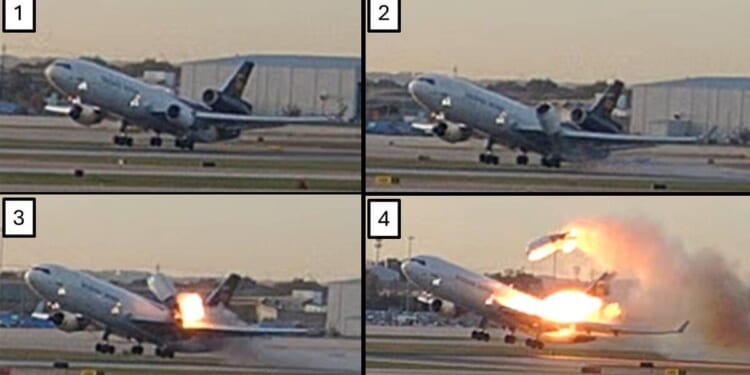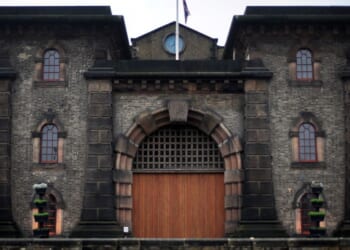Federal investigators have unveiled disturbing photographs of an engine breaking away from a doomed UPS cargo aircraft that went down a fortnight ago in Kentucky, resulting in 14 fatalities. The pictures show evidence of fractures in the left wing’s engine mounting.
A series of six photographs depict the rear section of the engine starting to detach before it rises above the wing amid a blast of flames. An image captures the wing being engulfed by fire whilst the blazing engine climbs overhead. The concluding photograph shows the aircraft beginning its take-off. Nevertheless, the MD-11 plane only succeeded in climbing 30 feet (9.1 metres) from the ground, according to the National Transportation Safety Board.
This detail was extracted from the flight data recorder and featured in their initial yet preliminary report regarding the 4 November disaster in Louisville, Kentucky.
The crash took the lives of three pilots aboard the aircraft and a further 11 individuals on the ground close to Muhammad Ali International Airport.
The NTSB stated the aircraft was not yet scheduled for a thorough inspection of crucial engine mount components that had cracks. It still required nearly 7,000 additional take-offs and landings.
Its most recent examination occurred in October 2021.
“It appears UPS was conducting this maintenance within the required time frame, but I’m sure the FAA is now going to ponder whether that time frame is adequate,” former federal crash investigator Jeff Guzzetti said after the release of the report. The onset of the cracks on the 34 year old aircraft remains unclear, as does whether they could have been overlooked during a previous inspection.
John Cox, another aviation expert, characterised fatigue cracks as “normal wear and tear on an aircraft.”
He explained that a metal component, such as the engine mount which vibrates each time the plane takes flight, will inevitably develop cracks over time. Cox emphasised that the frequency of inspections and necessary maintenance are the key considerations.
The NTSB report unveiled the first fresh details since board member Todd Inman briefed journalists on 7 November. He revealed that the cockpit voice recorder picked up an alarm sounding approximately 37 seconds after the UPS crew requested takeoff thrust.
Sean Garber, who reviewed the report and whose car salvage yard near the airport was directly impacted, described the incident as a man-made tragedy resulting from human error.
All MD-11s operated by UPS, FedEx and Western Global – along with a handful of related DC-10s – were grounded following the crash until they can be inspected and repaired. However, the Federal Aviation Administration has yet to specify what will be required.
Cox suggested that these air carriers “are going to have to make some hard decisions” given their existing plans to retire these planes in the coming years.
“If you have to remove the engines for a visual inspection or replacement, that’s going to incur a significant cost,” he warned.
MD-11 aircraft constitute roughly 9% of the UPS fleet and 4% of the FedEx fleet, according to the companies.
Earlier this week, Bill Moore, president of UPS Airlines, a division of UPS, stated that the company is collaborating with investigators to pinpoint the primary cause of the crash.
















